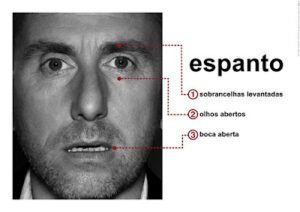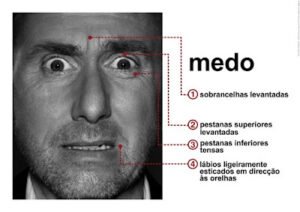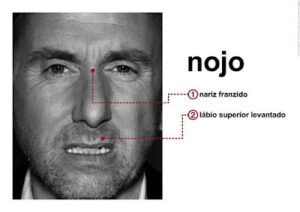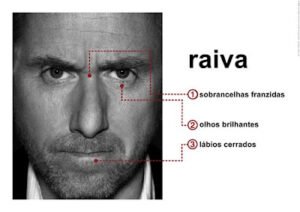What are facial microexpressions and what are their characteristics?

|
Getting your Trinity Audio player ready...
|
The study of facial microexpressions is a recent practice, started in the 70s by Dr. Paul Ekman, a renowned psychologist specializing in emotions and facial expressions, and takes a look at the quick, often imperceptible facial expressions that reveal our genuine emotions in the blink of an eye.
In this article, we will explore the world of facial microexpressions, examining their characteristics and the importance of recognizing them in our everyday communication.
What are facial microexpressions?
To the facial microexpressions, as the name suggests, are extremely quick and subtle facial expressions that last only a fraction of a second. As such, they occur involuntarily and are a direct reflection of the real emotions a person is feeling, as they are triggered automatically in response to our genuine emotions.
Above all, the facial microexpressions They appear and disappear quickly, often before the person realizes they are demonstrating something. In addition, they reflect what a person really feels at the moment, even if they try to hide or control their emotions.
Although they are difficult to detect, these microexpressions play a fundamental role in nonverbal communication and can provide insights valuable insights into what someone is truly feeling, as they reveal a great deal of emotional information.
Characteristics of facial microexpressions
1. Brevity
As mentioned earlier, one of the most striking features of facial microexpressions is their brevity. They last only about 1/25 to 1/15 of a second, making them difficult to see with the naked eye.
Example: A person who hears something disturbing may show anger or fear for a moment before returning to a neutral expression.
- Why is it important?
The suddenness reflects “raw” emotion, arising before the person has time to process or consciously control their reaction.
2. Involuntariness:
Unlike conscious facial expressions that we can control, facial microexpressions occur involuntarily. This means that they are a direct reflection of a person's real emotions, without filters or masks.
Example: A fake smile can mask displeasure, but a slight microexpression of disgust may appear before the smile.
- Why is it important?
It reveals what a person is really feeling, even when they are trying to hide it, and is useful for identifying it in contexts such as negotiations and interrogations.
3. Universality:
To the facial microexpressions are universal. This means that regardless of culture, basic emotions such as happiness, sadness, anger, fear, surprise, and disgust are expressed in the same way in microexpressions all over the world.
Example: A look of surprise (raised eyebrows, wide eyes and slightly open mouth) is universally recognized, whether in a Brazilian, Chinese or Swedish person.
- Why is it important?
It shows that these expressions are rooted in human biology, making them a global emotional language.
4. Difficulty of Detection:
Detect facial microexpressions requires training and practice. They are so quick that they often go unnoticed. Professionals in fields such as psychology, criminal investigation, and negotiation often receive specialized training to identify these microexpressions.
Example: Someone who is lying may display a microexpression of fear (indicating nervousness) before adopting a confident expression.
- Why is it important?
The difficulty of detection makes microexpressions powerful tools for trained professionals, such as psychologists, negotiators and security agents.
The work of Dr. Paul Ekman
Dr. Paul Ekman was born on February 15, 1934, in Washington, D.C., United States. Throughout his career, Paul Ekman made significant contributions to the field of psychology, particularly in the areas of the psychology of emotions, facial expressions, lie detection, and nonverbal behavior.
Paul Ekman's major accomplishments and contributions include:
1. Facial Action Coding System (FACS) and Emotion FACS (EMFACS):
In collaboration with Wallace V. Friesen, Paul Ekman developed FACS, a highly detailed coding system for describing and categorizing different facial muscle actions.
Both FACS and EMFACS are powerful tools for researchers who want to better understand human facial expressions and emotions. They also have practical applications in fields such as clinical psychology, actor training, and lie detection.
2. Studies on Universal Emotions:
Paul Ekman is known for his pioneering studies of human emotions. He demonstrated that some facial expressions of emotions are universal, meaning they are recognized and interpreted in similar ways across cultures around the world.
3. Lie Detection:
Ekman is an authority on lie detection and facial microexpressions. His work has influenced the application of his findings in areas such as national security and law enforcement.
4. Writing and Teaching:
He is the author of several popular books, including “Emotions Revealed” and “Telling Lies”, who have made his research accessible to the general public. In addition, Ekman has taught at several higher education institutions and shared his knowledge in lectures and trainings.
Paul Ekman is widely respected for his work and has had a significant impact on the understanding of human emotions, facial expressions, and nonverbal behavior. His research and contributions continue to influence fields such as psychology, psychiatry, safety, and interpersonal communication.
The Importance of Recognizing Facial Microexpressions
Recognize the facial microexpressions can be extremely useful in many areas of life. In the context of social interactions, it can help improve empathy and understanding of other people’s emotions. In addition, professionals who deal with negotiations, such as salespeople and mediators, can use this knowledge in key situations.
The series Lie to Me, currently available at streaming from Disney+, references the work of Dr. Paul Ekman, applying FACS and identifying microexpressions, through the protagonist, the character Carl Lightman, a consultant for the FBI and CIA, who assists in investigations of crimes and threats. The series also addresses the contexts of nonverbal communication and body language, which makes the subject more interesting, although always with a hint of exaggeration, common to the theater inherent in television and film productions. But here is the reference.
What are the cataloged facial microexpressions?
Dr. Paul Ekman, in his research, defined 7 universal emotions: disgust, anger, fear, sadness, joy, surprise (or astonishment) and contempt. The promotional material for Lie to Me, features the main actor, Tim Roth, simulating the expressions catalogued by Dr. Paul with the main points to be observed:







How to Detect Facial Microexpressions
Detect facial microexpressions requires practice and careful observation. Here are some tips to help you get started:
1. Specialized Training:
Consider taking specialized training in microexpression detection. There are courses available that can enhance your skills.
2. Observe the Eyes and Mouth:
Pay special attention to the person's eyes and mouth. These areas of the face often reveal microexpressions most easily.
3. Context of the Situation:
Consider the context of the situation. Sometimes microexpressions can be ambiguous, but context can help you interpret them correctly.
4. Practice with Friends:
Practice spotting microexpressions with friends and family to hone your observation skills.
In short…
To the facial microexpressions Microexpressions are windows into people’s genuine emotions. Although they are difficult to detect, the knowledge and ability to recognize them can significantly improve our social interactions and our understanding of human emotions. So don’t underestimate the power of facial microexpressions in everyday communication and consider investing time and effort into honing your detection skills.
In this article, we explored what micro facial expressions are and their main characteristics. We hope you have gained a deeper understanding of this fascinating aspect of nonverbal communication.
Recommended Reading:
The Language of Emotions – Paul Ekman (Author); Carlos Szlak (Translator)
Image: Freepik
Article originally published on 09/02/2023 and updated on the date above.

Marcel Castilho is an expert in neuromarketing, neuroscience, mindfulness and positive psychology. In addition to being an advertiser, he also has a Master's degree in NLP – Neurolinguistic Programming. As the owner and founder of the communications agency VeroCom and also of the digital agency Vero Contents, he has been studying human behavior for over 30 years.



